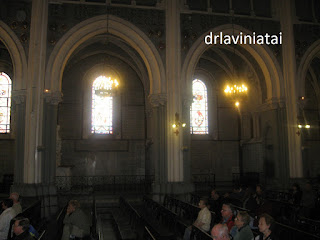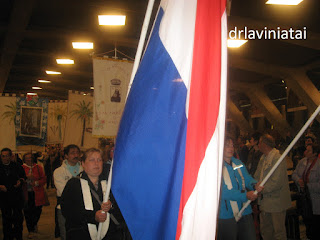The Crypt (La Crypte) in Lourdes, France
Situated between the The Basilica of the Immaculate Conception and the Rosary Basilica is the Crypt which stands on the Rock of Massabielle. Built between the years 1863 and 1866, it was the first of the churches to be completed in the Sanctuary of Our Lady of Lourdes in response to the request of Our Lady during the thirteenth apparition, "Go and tell the priests to build a chapel here." The construction of the Church was initiated by Father Peyramale, the parish priest of Lourdes. Building work started on 13 September 1863 under the supervision of Hippolyte Durand, a French architect who specialized in medieval church architecture. The new church was consecrated on 19 May 1866 by Monsignor Laurence, the Bishop of Tarbes and Lourdes, in the presence of Bernadette. Her departure for the convent of Saint Gildard in Nevers was delayed so that she could witness this special consecration ceremony. Francois Soubirous (Bernadette's father), who had worked on its construction, was also present to witness its official opening.
The Main Altar
The Crypt has three naves with Gothic vaulted ceilings and can accommodate 120 people. Its notable feature are its 28 Pyrenean marble columns which support the weight of the Basilica of the Immaculate Conception constructed atop the Crypt. The high altar was restored in 1966. Above the altar, there is a statue of the Virgin Mary and Child Jesus with a golden halo sculpted by the French sculptor, Joseph-Hugues Fabisch, in 1868. The Church contains four chapels dedicated to the Sacred Heart of Jesus, Saint Joseph, Saint Peter, and Saint John the Evangelist. Bernadette's fifth right rib, which was removed from her body in 1925 when her body was exhumed for a third time, can also be found in the Crypt.
The Chapel dedicated to the Sacred Heart of Jesus
The Chapel dedicated to Saint Joseph
The Chapel dedicated to Saint Peter
The Chapel dedicated to Saint John the Evangelist
Hewn out of the rock, the Crypt is beautiful but has to be unusually small in order to enhance its stability. Prior to the year 1904, visitors could only enter the Crypt by way of two underground passages. However, these passages were closed for the purpose of strengthening the foundations of the Basilica of the Immaculate Conception constructed above the Crypt. Today, visitors can enter the Crypt through a corridor in the central passage. At the entrance, visitors will be able to see statues of St. Peter holding the Keys of Heaven, Pope Pius X administering the sacrament of Eucharist, and St. Bernadette depicted as the poor shepherd girl of Bartres.
Statue of St. Peter holding the Keys of Heaven
Statue of Pope Pius X administering the Eucharist
Above the entrance of the Crypt is a mosaic medallion of Pope Pius X holding a parchment in his hands with the words "To Mary Immaculate". Outside the Crypt is the church courtyard below which is the Rosary Basilica. From the church courtyard, visitors can see the Grotto, the Gave de Pau River flowing past the Grotto, the Castle of Lourdes, and most of the town of Lourdes.
The Crypt is a place of silence where we can reflect upon our own lives and get closer to God through personal prayer. As what Cardinal Robert says, "Through silence, we return to our heavenly origin, where there is nothing but calm, peace, repose, silent contemplation, and adoration of the radiant face of God. The importance of silence is clearly emphasized in his book entitled The Power of Silence: Against the Dictatorhip of Noise.
The Crypt is a place of silence where we can reflect upon our own lives and get closer to God through personal prayer. As what Cardinal Robert says, "Through silence, we return to our heavenly origin, where there is nothing but calm, peace, repose, silent contemplation, and adoration of the radiant face of God. The importance of silence is clearly emphasized in his book entitled The Power of Silence: Against the Dictatorhip of Noise.
You may also like to read THE PARISH CHURCH OF LOURDES, BASILICA OF SAINT PIUS X, and THE CHURCH OF SAINT BERNADETTE. To view the content page of this blog, please click here.
References:
1. Lourdes & Bernadette. Publisher "il Calamo"
2. Lourdes. Doucet Publications.
3. Discover Lourdes. MSM.
4. The Power of Silence: Against the Dictatorship of Noise. Ignatius Press.











































